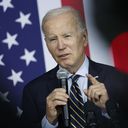U.S. deficit will soar in the next decade, new CBO projections show

The U.S. deficit is expected to climb over the next 10 years with higher interest payments set to account for a historic share of government spending, the Congressional Budget Office said on Wednesday.
Why it matters: New projections from the nonpartisan agency show deficits jumping from $1.6 trillion this year to $2.6 trillion in 2034, alongside a slightly less gloomy prediction for the nation's fiscal health than previously estimated.
By the numbers: The deficit will be 5.6% of GDP this year before jumping to 6.1% in 2025, and ultimately holding at that level in 2034.
- In its outlook, the CBO notes that deficits have exceeded this share of GDP only in periods of economic crises, not as the U.S. economy has boomed.
- "The primary deficits in CBO's projections are especially large given the relatively low unemployment rates that the agency is forecasting," the CBO says in its outlook.
- Meanwhile, debt held by the public would rise from 99% of GDP at the end of this year to 116% of economic output by 2034 — the highest level ever recorded.
The intrigue: The CBO says interest payments on the debt are a huge contributor to the deficit, with the ballooning cost equal to roughly three-quarters of the deficit increase over the next 10 years.
- Stunning stat: Starting next year, interest costs will be a greater share of GDP than at any point since at least 1940, the CBO says in its outlook — the first time it reported such data.
What they're saying: In a statement, CBO director Phillip Swagel said that the amount spent on interest costs is initially similar to discretionary spending — such as that spent on defense and non-defense programs.
- But by the end of the period, Swagel said the interest costs "are roughly one and half times larger than each."
- The aging population and the expected growth in Social Security and Medicare are other factors that will contribute to soaring deficits, Swagel said.
Catch up fast: The government's spiking interest payments are in part a side-effect of the Fed's historic campaign to wrestle inflation, which resulted in decades-high borrowing costs.
- The CBO expects the Fed will begin to lower interest rates later this year, but rates in the coming years will be "generally higher" than it previously expected.
- "Those higher rates mostly reflect the effects of stronger-than-expected economic growth in 2023. In later years, higher rates are driven by more capital income and less private saving," the CBO outlook says.
Of note: The deficit for 2024 is $63 billion lower than the CBO anticipated last spring. Meanwhile, the cumulative budget shortfall over the next decade is also less than initially forecast.
- The key reason to its slightly sunnier projection: recent legislation that capped spending.
- The other reason for the smaller deficit: faster economic growth, partly because of more people working thanks to higher net immigration.
In a statement, the White House said the CBO report was "further evidence of economic strength and deficit reduction under President Biden."
- "The economy continues to grow faster than forecast as inflation continues to fall, while the deficit is projected to be lower over the next decade than CBO last projected," the statement says.
Editor's note: This story was updated with comment from the White House and additional context.